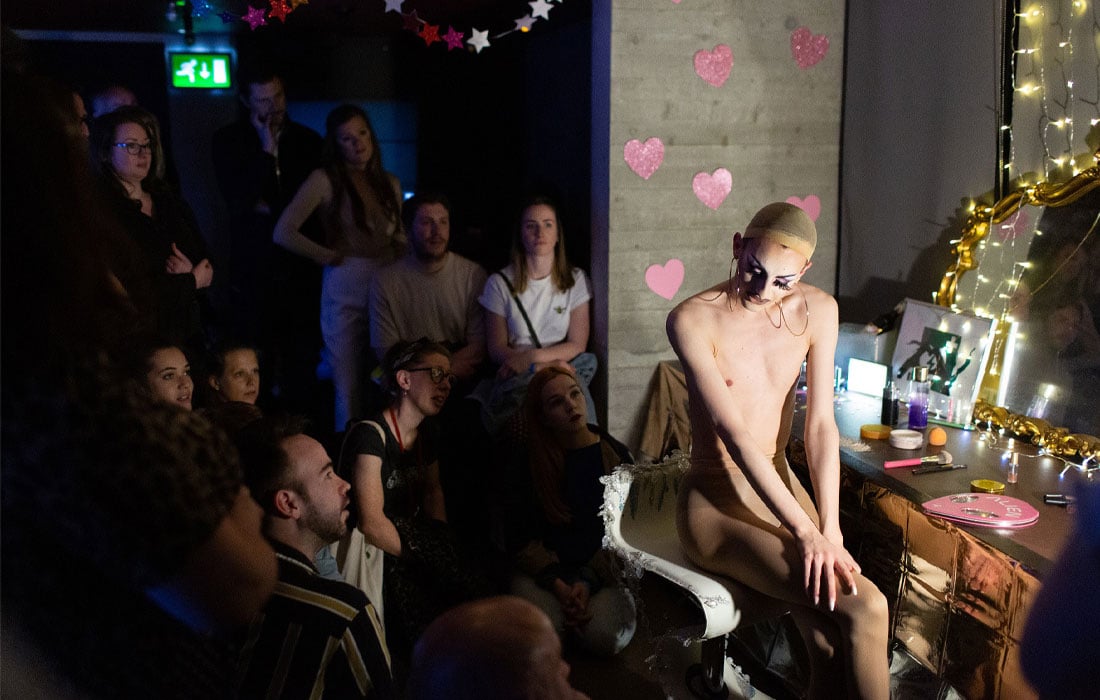
Photo: © Matt Thomas
Shining a light on local culture
The LightNight festival initially aimed to showcase Liverpool's artists to outsiders – but it is now more concerned with galvanising the local cultural scene, writes Laura Marie Brown.
In one of the final performances at this year's LightNight Liverpool, Bring the Fire Project freed the 'Wicker Woman' from the shackles of the patriarchy. The crowd of several hundred, gathered at Blackburne House, cheered. It was the end of a night of over a hundred arts events taking place across the city.
“Over the years we’ve built up enough experience to use our intuition to best effect, finding the most likely matches to help find the right platform for a particular artist”
This was the tenth LightNight. On this one-night culture crawl the city’s arts and cultural venues, and various other places and spaces, open their doors until late, to showcase the breadth of Liverpool’s artists, performers, musicians and creatives. And it is all free.
It was born out of Liverpool’s year as European Capital of Culture in 2008, aimed at increasing participation in the arts and creating a safer and more audience-friendly city centre at night.
While audiences are a key part of LightNight, it isn’t just for them. It was also designed to encourage and foster collaboration and partnership across, and beyond, the arts sector. It would help emerging artists develop their practice and provide them with vital inroads into the arts scene.
Open programming
Artists first get in touch via an open programming call. The team of producers at Open Culture spend time on each submission, thinking about how the work will fit into the festival programme. Christina Grogan is one of three producers, along with Charlotte Corrie and Rachael Jones. They bring in freelancers and volunteers to work on the festival, but the year-in, year-out work of building relationships between artists and venues sits with them.
Christina says: “Over the years we’ve built up enough experience to use our intuition to best effect, finding the most likely matches to help find the right platform for a particular artist.”
If they haven’t worked with an artist before, they pick up the phone or invite them for a coffee so they can get a better feel for what they do. The next step is to have conversations with venues and programmers to find a good fit. Sometimes it ends up as a LightNight event, sometimes not. The most important factor is that it is a stepping stone for artists to develop a practice or reach an audience they might not normally have.
The festival programme also includes special commissions and new works, often site-specific, which require a great deal of planning and organisation between artist, venue and producer. In 2016, artist Laura Brownhill and TiLT Dance created one of the new works, Météo-Dock, commissioned by LightNight and Liverpool Albert Dock. An ‘experimental weather-ship’, it was a promenade performance featuring a crew of eight dancers and musicians.
Laura says: “Due to the ambitious nature of my work and the equally ambitious schedule of the programme, my team and the LightNight team have always had to work incredibly hard together on logistics to deliver a good show in the public domain. This strength has just improved the facilitator/artist relationship over the years making LightNight a very credible fixture in the Liverpool calendar for artists and audiences alike.”
City showcase
As well as having an impact on artists, LightNight has also changed the city. Liverpool’s cultural community has a platform to create an eclectic programme of arts and culture activities, responding to a single theme on one evening. It is perfectly possible to start the evening off seeing a Baraat (traditional Indian street dance), followed by a light installation at an underground station, nip into a talk at a museum before dancing the night away to music programmed by an artist collective.
The festival is a showcase. When it began, it was more outward-facing, more about trying to show people from outside the region the impressive range of artists. Now it helps to galvanise the arts scene and demonstrates that Merseyside is a viable place for artists to live and work. The fact that thousands of people come out to enjoy it has an energising effect on the people producing work here and lets us stretch our legs creatively for new audiences.
Laura Marie Brown is a freelance writer and responsible for PR and communications at Open Culture.
http://lightnightliverpool.co.uk
LightNight Liverpool will return on Friday 15 May 2020 with the theme ’Home’. To take part email [email protected]
Join the Discussion
You must be logged in to post a comment.